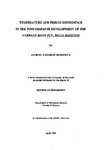TEMPERATURE AND PERIOD DEPENDENCE IN THE POST-DIAPAUSE DEVELOPMENT OF THE CABBAGE ROOT FLY, DELIA RADICUM
| dc.contributor.author | ROBERTS, LORNE GEORGE | |
| dc.contributor.other | School of Biological and Marine Sciences | en_US |
| dc.date.accessioned | 2013-11-01T10:53:16Z | |
| dc.date.available | 2013-11-01T10:53:16Z | |
| dc.date.issued | 1994 | |
| dc.identifier | NOT AVAILABLE | en_US |
| dc.identifier.uri | http://hdl.handle.net/10026.1/2523 | |
| dc.description.abstract |
The cabbage root fly (Delia radicum (L.) (Diptera: Anthomyiidae) (Pont, 1981)), as it is known in the U.K. (Anon.,1947), or the cabbage maggot, as it is known in North America and Canada (Muesebeck, 1942) has been described by a number of different generic names and specific epithets. First described by Bouche in 1833 as Anthomyia brassicae, it is also known as Hylemyia, Erioischia, Chonophila, Phorbia and Delia brassicae. However, it is known now as Delia radicum (L.). D. radicum is found to cause serious damage to brassica crops in the Holarctic region (35-60°N) (Shoene, 1916; de Wilde, 1947). It is particularly destructive of cabbages and cauliflowers but also attacks Brussels . sprouts, radishes, turnips, swedes (Coaker & Finch, 1971), kale, mustard, broccoli and rape. The damage is caused by the larvae which eat and burrow through the cortical tissue of the main tap root and lateral roots. Occasionally, they feed on the aerial parts of the plant as well. | |
| dc.description.sponsorship | ADAS, Starcross | en_US |
| dc.language.iso | en | en_US |
| dc.publisher | University of Plymouth | en_US |
| dc.title | TEMPERATURE AND PERIOD DEPENDENCE IN THE POST-DIAPAUSE DEVELOPMENT OF THE CABBAGE ROOT FLY, DELIA RADICUM | en_US |
| dc.type | Thesis | |
| plymouth.version | Full version: final and full version as approved by the examiners at the time of the award of your degree | en_US |
| dc.identifier.doi | http://dx.doi.org/10.24382/3903 | |
| dc.identifier.doi | http://dx.doi.org/10.24382/3903 |
Files in this item
This item appears in the following Collection(s)
-
01 Research Theses Main Collection
Research Theses Main


